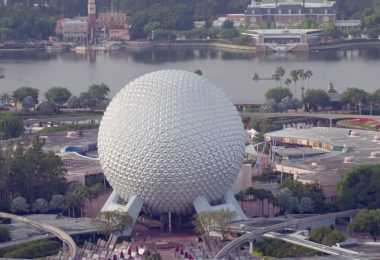By Beth Deitchman
Some folks are seasoned world travelers, ready to throw a backpack over a shoulder and traipse across the world to experience new sights and cultures, while some of us are at our happiest exploring every inch of a Disney theme park. Epcot’s World Showcase is our shared happy place—an immersive experience that takes guests through 11 “countries” and more than 4,000 years of history, culture, and food.
Reminiscent of a world’s fair, World Showcase’s 11 themed pavilions are all wildly unique, designed to reflect the architecture, landscapes, and streetscapes of countries from all over the globe. They’re each staffed by cultural representatives from the nations they represent, and as you stroll around the World Showcase Lagoon—enjoying an around-the-world journey over the course of a single visit to Epcot—you might take note of these real-life landmarks’ influence on the World Showcase pavilions.
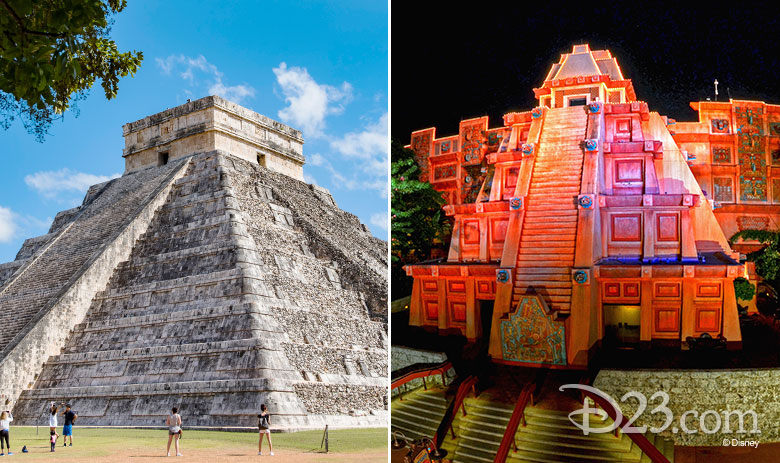
1. Mexico pavilion: El Castillo pyramid
The impressive 36-foot-tall pyramid that welcomes guests to the Mexico pavilion was inspired by architectural elements of ancient Mesoamerican civilizations. Among these was El Castillo, also known as the Temple of Kukulkan, built by the Mayans sometime between 800 and 1100 A.D. at Chichén Itzá in Mexico’s Yucatan state. Each of El Castillo’s four sides features a stairway comprised of 91 steps—add the final step to the pyramid’s top, and you end up with a total of 365 in all. The Mayans, who were early scientists and astronomers, designed the pyramid to display a very special effect: Twice a year, when the spring and fall equinoxes take place, a shadow falls on the pyramid that appears to take the shape of a serpent. And, in a bit of natural “Imagineering,” as the sun goes down, the snake also appears to descend…
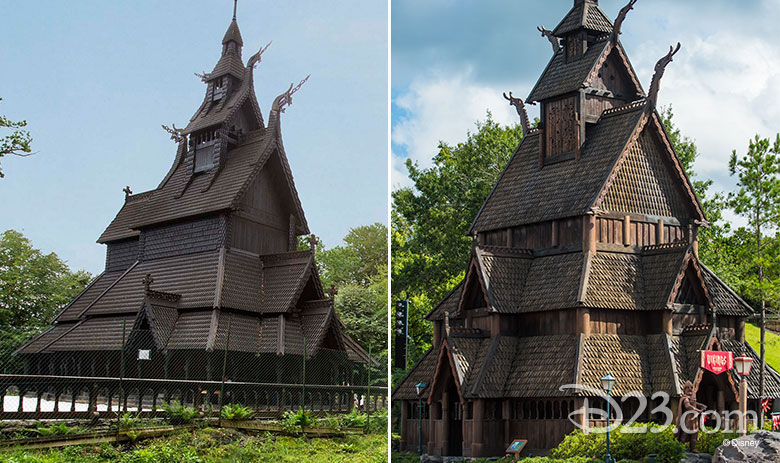
2. Norway pavilion: Stave Church
The pavilion’s Stave Church Gallery showcases artifacts and items that demonstrate how Norway’s rich culture influenced Walt Disney Animation Studios’ Frozen. And speaking of frozen fractals, stave churches—which were very common in Norway around the 13th century—were designed with steeply slanted roofs to keep snow falling to the ground, rather than accumulating on the roof and causing a collapse. The churches were named for their construction with wood frames and load-bearing posts that were called stafr in Old Norse, but are now called stavs in modern Norwegian.
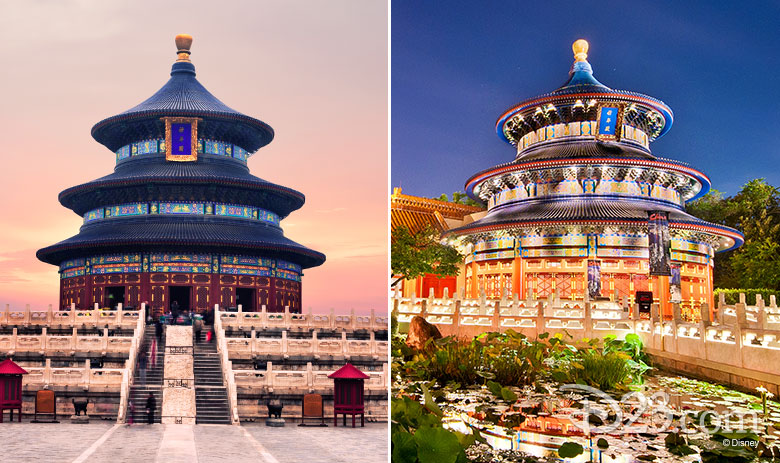
3. China pavilion: Temple of Heaven
Just beyond the Gate of the Golden Sun in the China pavilion stands the Temple of Heaven, which houses the 14-minute Circle-Vision 360° film Reflections of China. The building is a replica of a structure erected in Beijing, China, in the early 1400s that emperors of the Ming and Qing dynasties would visit each year to pray for good harvests. The China landmark symbolizes the relationship between heaven and earth, with its rectangular base intended to represent our world and its rounded upper structure evoking something more otherworldly.
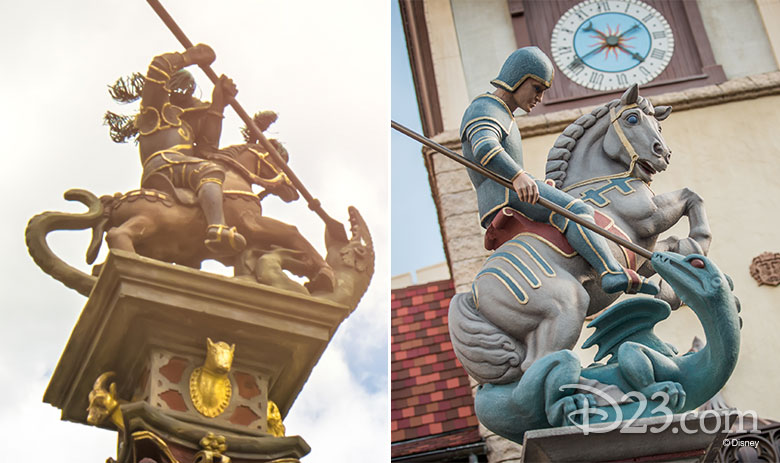
4. Germany pavilion: St. George and the Dragon statue
The Germany pavilion, which resembles a quaint German village’s town square, or platz, has at its center a replica of a statue that is located in the Bavarian town of Rothenburg ob der Tauber and celebrates of the legend of St. George and the Dragon. As the story goes, St. George was the unlikely hero who successfully took on a dragon that was terrorizing a small kingdom (and claimed the king’s daughter as tribute).

5. Italy pavilion: St. Mark’s campanile
Though nods to iconic Italian sites and architecture are on display throughout the Italy pavilion, the towering replica of St. Mark’s campanile, or bell tower, can be seen from afar and sets the tone for an experience that is truly magnifico. Venice, Italy’s campanile was originally constructed in the ninth century and used as a watchtower or lighthouse. In addition to inspiring the lofty landmark at Epcot, the St. Mark’s campanile inspired the design of towers around the world, including New York City’s famed Met Life Tower.

6. The American Adventure: Independence Hall
The American Adventure pavilion is designed in the Georgian style that can be seen in Philadelphia’s Independence Hall, as well as the Old State House in Boston—both of which evoke the sense they are mansions that belong to the people, rather than a single land owner. Like both of these historic buildings, The American Adventure features a prominent steeple, a clock tower, and red bricks—110,000 of them, to be exact. Disney Imagineers spent five years completing The American Adventure pavilion, which was built with bricks of Georgia red clay that were aged for authenticity.
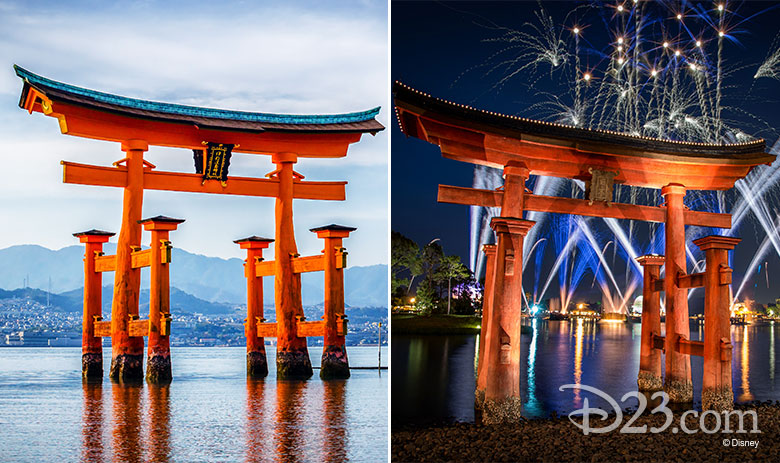
7. Japan pavilion: torii gate
The floating torii of Itsukushima Shrine on Miyajima is among Japan’s best-known landmarks. Its waterside location and traditional vermilion hue are echoed in the torii gate that welcomes guests to the Japan pavilion from the World Showcase Lagoon. The torii typically marks the entrance to a sacred space and can be spotted all over Japan in a range of sizes, from just a few inches tall to large structures that span across roads.
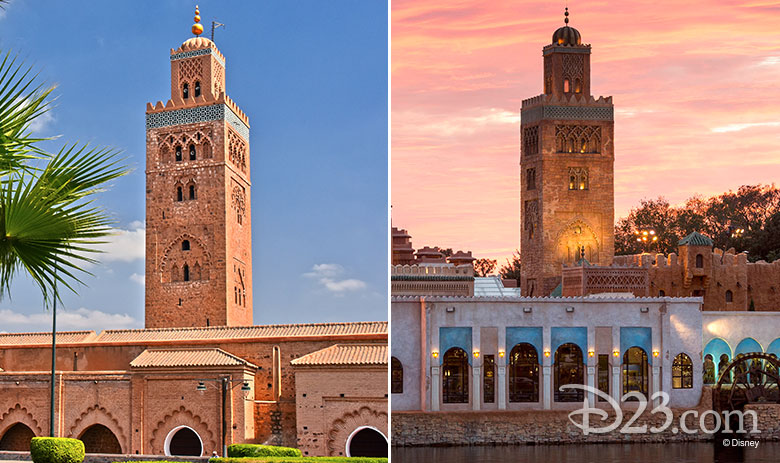
8. Morocco pavilion: Koutoubia Minaret
From narrow streets and intimate spaces to the hand-laid tile beneath your feet, the Morocco pavilion is an especially immersive experience at World Showcase. Perhaps its most striking feature is the Koutoubia Minaret, a replica for the icon located at Koutoubia Mosque in Marrakech—the largest mosque in Morocco. When the landmark was finished in the 12th century, it was a gathering place for booksellers—considered a most honorable trade. The merchants plied their trade around the minaret’s base and inspired its name, which is derived from the word for booksellers, kutubiyyin.
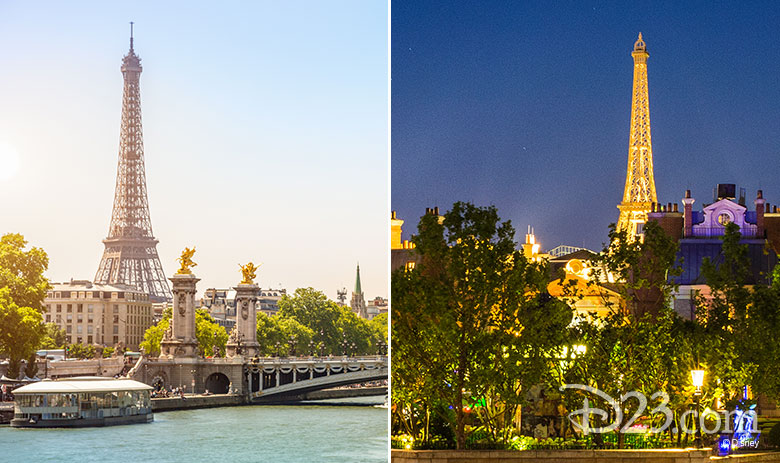
9. France pavilion: Eiffel Tower
One of the most recognizable spots around the globe, naturally Paris’ Eiffel Tower is represented in World Showcase. Of course, Epcot’s version of Gustave Eiffel’s design is somewhat smaller than the original—it’s 1/10 scale of the Parisian tower and stands 103 feet tall. As beautiful as the Tower’s design may be, it has a scientific legacy that may surprise folks who think of it as a symbol of love and the City of Light. Originally built to stand for 20 years, Gustave Eiffel encouraged its use for scientific experiments in radio transmissions and in telecommunications. Now, 128 years later, the Eiffel Tower welcomes almost 7 million visitors a year. C’est magnifique!
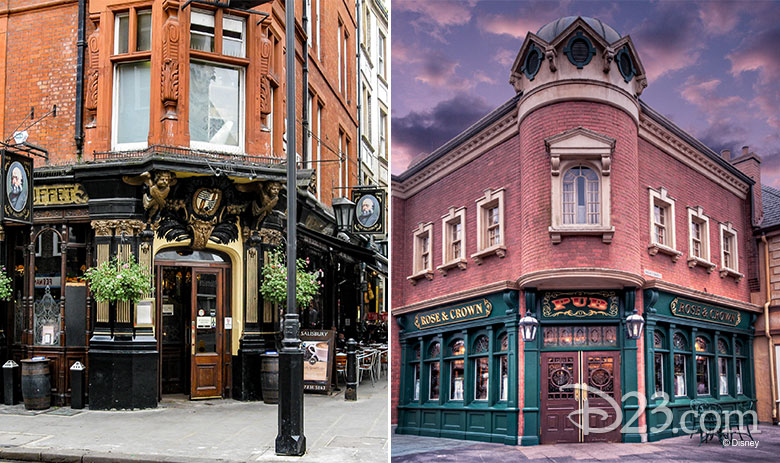
10. United Kingdom pavilion: Tudor pub
Quintessentially British features of the United Kingdom pavilion include red phone booths, lush English gardens (complete with a hedge maze!), and a cobblestone street. But as you walk along the high street and approach the Rose & Crown Dining Room, you’ll see a progression of styles that demonstrates British architecture over different time periods—from an early cottage to a Tudor pub with its timber framing to an elegant Victorian bar. As you amble about the pavilion, you might also look for nods to the ultra-posh Hampton Court Palace and the quaint cottage where Anne Hathaway—the other Anne Hathaway, who married William Shakespeare—once resided.
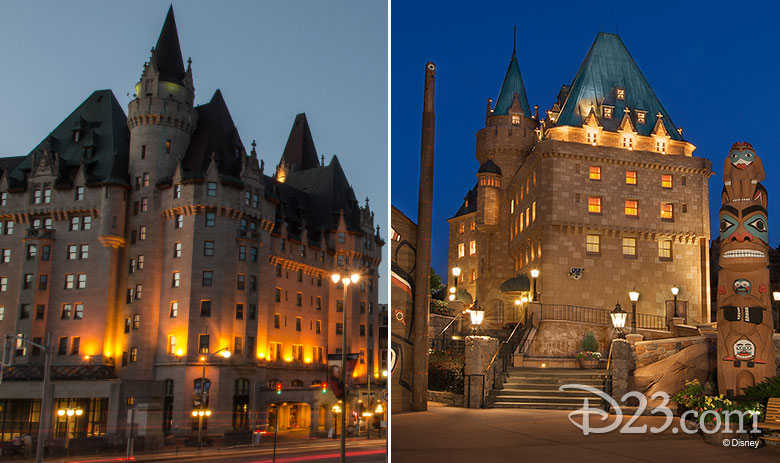
11. Canada pavilion: Chateau Laurier
Your journey “north” to the Canada pavilion includes a spectacular tribute to the nation’s natural wonders, such as the majestic Rocky Mountains, a 30-foot waterfall, and beautifully landscaped grounds that are inspired by Victoria’s Butchart Gardens. But you simply can’t miss one of the more striking man-made landmarks in the pavilion: the Hotel du Canada, inspired by the Chateau Laurier in Ottawa. The hotel was commissioned by railroad magnate Charles Melville Hays, who was extending his Grand Trunk Pacific Railway west, and envisioned several deluxe hotels along the route. The hotel was impeccably furnished within and boasted a façade that featured Italian marble, Indiana limestone, and a copper roof. One hundred and five years after its grand opening, the Chateau Laurier is still welcoming guests to this day.



